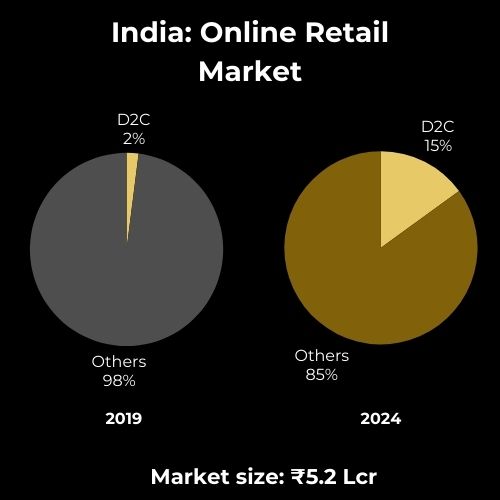The Evolution of D2C Brands in India's E-commerce Landscape
Over the past few years, the Indian e-commerce landscape has witnessed a remarkable transformation. Direct-to-Consumer (D2C) brands have emerged as a significant force, leveraging their own websites, apps, and social media channels to reach customers directly. This shift has seen the share of direct e-commerce sales by brands grow from a mere 2-3% five years ago to an impressive 10-15% of India’s online retail market, now valued at ₹5.86 lakh crore.

The Marketplace vs. Direct Channel Dilemma
Despite this growing trend, analysts assert that horizontal marketplaces (Amazon, Flipkart) and vertical marketplaces (Nykaa, Myntra) will continue to dominate the online retail market. Nonetheless, senior executives of D2C brands acknowledge the growing importance of direct e-commerce as a crucial part of their channel mix.
Marketplaces offer a vast customer base but come with limitations. They provide little flexibility for brands to fine-tune their offerings and drive repeat purchases. As a result, while being present on marketplaces is essential for visibility, maintaining a portion of sales through their own websites is key for D2C brands. This strategy not only enhances profitability but also enables brands to stand out in an increasingly crowded marketplace, especially in verticals like apparel.
Enablers of Direct E-commerce Growth
Several factors have contributed to the rise of direct e-commerce. The availability of tools such as payment gateways, logistics aggregators, and marketing services on social networks has empowered brands to sell directly to consumers. Among these, advancements in logistics have been particularly significant. Improved logistics capabilities have enabled brands to compete with the speed and quality of delivery offered by giants like Amazon and Flipkart.
In the last five years, consumer adoption of brand-owned websites has increased significantly. Customers are beginning to trust these platforms more, allowing brands to sell more profitably and gain better consumer insights through their own channels.
The Role of Quick Commerce
However, the rise of quick commerce presents a potential challenge to the decline in marketplace dependence. Quick commerce, particularly in categories such as FMCG, home-care, and beauty products, has become the fastest-growing channel. This trend has accelerated the growth of food brands, which can scale rapidly using this new channel.
The Path Forward: Balancing Direct and Marketplace Channels
While selling through their own websites brings numerous advantages for brands, it is predominantly the larger brands that can fully leverage this strategy. Smaller brands still need the platform of established e-commerce companies to reach a broader audience, as a majority of customers still gravitate towards these marketplaces.
Conclusion: The Importance of Strategic Partnerships
For D2C brands to successfully navigate the complex e-commerce landscape, having the right partners and DTC experts is crucial. Firms like Encompass Ideas can assist brands in establishing credibility and social-proofing in the market. By providing the right connections and helping brands navigate the marketing landscape, these partners can drive credible growth and value, ensuring that D2C brands achieve sustainable success in an increasingly competitive environment.
